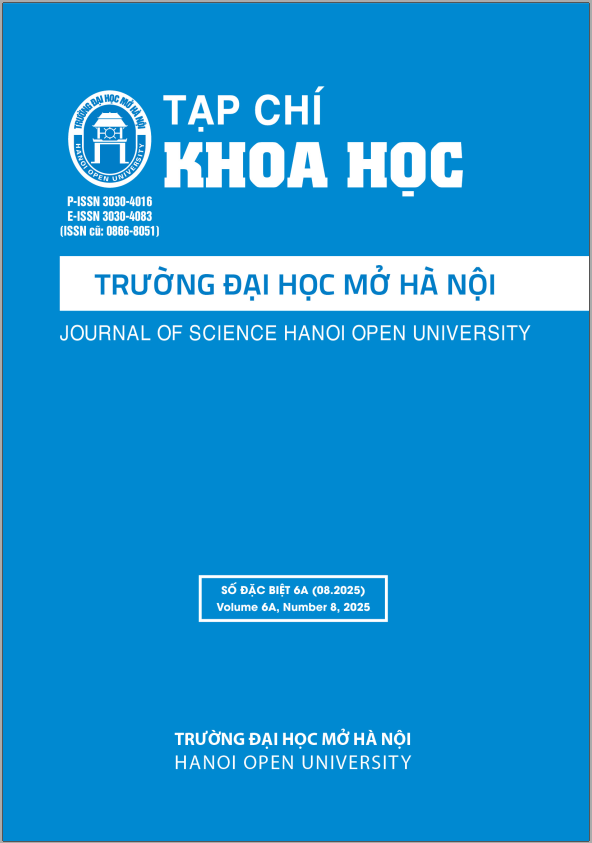AI TRONG VIẾT BÁO QUỐC TẾ: CƠ HỘI, RỦI RO VÀ CHIẾN LƯỢC TỪ CÁC TÁC GIẢ THÀNH CÔNG TRÊN THẾ GIỚI
DOI:
https://doi.org/10.59266/houjs.2025.673Từ khóa:
trí tuệ nhân tạo, viết bài báo khoa học, xuất bản quốc tế, đạo đức nghiên cứu, chiến lược nghiên cứuTóm tắt
Việc ứng dụng trí tuệ nhân tạo (AI) vào quá trình viết bài báo khoa học quốc tế đang mở ra nhiều cơ hội mới, đồng thời đặt ra không ít thách thức. Bài báo này phân tích vai trò của AI trong việc nâng cao hiệu quả, cải thiện chất lượng nội dung của bản thảo để đáp ứng tiêu chuẩn của các tạp chí học thuật toàn cầu. AI có thể được sử dụng để tìm kiếm tài liệu, phân tích dữ liệu, gợi ý về đề cương, chỉnh sửa chính tả và cách hành văn theo ngôn ngữ tự nhiên giúp nhà nghiên cứu tiết kiệm thời gian khi viết báo, đẩy nhanh tiến độ xuất bản. Tuy nhiên, những rủi ro như thông tin sai lệch, vấn đề đạo đức và nguy cơ phụ thuộc quá mức vào AI có thể ảnh hưởng đến tính xác thực của nghiên cứu. Dựa trên kinh nghiệm từ các nhà nghiên cứu thành công và các nghiên cứu gần đây, chúng tôi đề xuất các chiến lược nhằm tận dụng tối đa lợi ích của AI, đồng thời giảm thiểu rủi ro, bao gồm đào tạo kỹ năng sử dụng AI có trách nhiệm, gợi ý xây dựng quy chuẩn đạo đức và kết hợp sáng tạo của con người với công nghệ AI. Thông qua phân tích một số trường hợp điển hình và xu hướng hiện tại, nghiên cứu này cung cấp gợi ý, giúp các nhà khoa học khai thác hiệu quả AI để tạo ra những bài báo chất lượng, có sức ảnh hưởng lớn.
Tài liệu tham khảo
[1]. Bobier, C., Rodger, D., & Hurst, D. (2025). Artificial intelligence policies in bioethics and health humanities: A comparative analysis of publishers and journals. BMC Medical Ethics, 26(1), 79. https://doi.org/10.1186/s12910- 025-01239-9
[2]. Buriak, J. M., Akinwande, D., Artzi, N., Brinker, C. J., Burrows, C., Chan, W. C. W., Chen, C., Chen, X., Chhowalla, M., Chi, L., Chueh, W., Crudden, C. M., Di Carlo, D., Glotzer, S. C., Hersam, M. C., Ho, D., Hu, T. Y., Huang, J., Javey, A.,... Ye, J. (2023). Best practices for using AI when writing scientific manuscripts: Caution, care, and consideration: Creative science depends on it. ACS Nano, 17(5), 4091-4093. https://doi. org/10.1021/acsnano.3c01544
[3]. Carey, M. A., Steiner, K. L., & Petri, W. A., Jr. (2020). Ten simple rules for reading a scientific paper. PLOS Computational Biology, 16(7), Article e1008032. https://doi.org/10.1371/ journal.pcbi.1008032
[4]. Catterall, M. (2024). Advice to young researchers: With reflections on how to get a paper published. Qualitative Market Research: An International Journal, 27(4), 545-551. https://doi. org/10.1108/QMR-05-2024-0073
[5]. Chetwynd, E. (2024). Ethical use of artificial intelligence for scientific writing: Current trends. Journal of Human Lactation, 40(2), 211-215. https://doi. org/10.1177/08903344241235160
[6]. Cooperman, S. R., & Brandão, R. A. (2023). AI assistance with scientific writing: Possibilities, pitfalls, and ethical considerations. Foot and Ankle Surgery: Techniques, Reports & Cases, 3(4), Article 100350.
[7]. Ecarnot, F., Seronde, M.-F., Chopard, R., Schiele, F., & Meneveau, N. (2015). Writing a scientific article: A step-by-step guide for beginners. European Geriatric Medicine, 6(6), 573-579. https://doi.org/10.1016/j. eurger.2015.08.005
[8]. Gundall, M., Strufe, M., Schotten, H. D., Rost, P., Markwart, C., Blunk, R., Neumann, A., Grießbach, J., Aleksy, M., & Wübben, D. (2021). Introduction of a 5G-enabled architecture for the realization of Industry 4.0 use cases. IEEE Access, 9, 25508-25521. https://doi.org/10.1109/ ACCESS.2021.3057675
[9]. Hamed, A. A., & Wu, X. (2024). Detection of ChatGPT fake science with the xFakeSci learning algorithm. Scientific Reports, 14(1), Article 16259. https://doi.org/10.1038/s41598-024- 66784-6
[10]. Hammad, M. (2023). The impact of artificial intelligence (AI) programs on writing scientific research. Annals of Biomedical Engineering, 51(3), 459-
https://doi.org/10.1007/s10439- 023-03140-1
[11]. Khalifa, M., & Albadawy, M. (2024). Using artificial intelligence in academic writing and research: An essential productivity tool. Computer Methods and Programs in Biomedicine Update, 5, Article 100145. https://doi. org/10.1016/j.cmpbup.2024.100145
[12]. Khaleel, M., Nassar, Y., & El- Khozondar, H. J. (2024). Towards utilizing artificial intelligence in scientific writing. International Journal of Electrical Engineering and Sustainability, 2(1), 45-50.
[13]. Kwon, D. (2025). Is it OK for AI to write science papers? Nature survey shows researchers are split. Nature, 641(8063), 574-578. https://doi. org/10.1038/d41586-025-01463-8
[14]. Mondal, H., & Mondal, S. (2023). ChatGPT in academic writing: Maximizing its benefits and minimizing the risks. Indian Journal of Ophthalmology, 71(11), 3600-
https://doi.org/10.4103/IJO.IJO_718_23
[15]. Salvagno, M., Taccone, F. S., & Gerli, A. G. (2023). Can artificial intelligence help for scientific writing? Critical Care, 27(1), Article 75. https://doi. org/10.1186/s13054-023-04380-2
[16]. Sonni, A. F. (2025). Digital transformation in journalism: Mini review on the impact ofAI on journalistic practices. Frontiers in Communication, 10, Article 1535156. https://doi. org/10.3389/fcomm.2025.1535156
[17]. Vasconcelos, S., & Marušić, A. (2025). Gen AI and research integrity: Where to now? EMBO Reports, 26(8), 1923-1928. https://doi.org/10.1038/s44319-025-00424-6
[18]. Wohlfarth, B., Streit, S. R., & Guttormsen, S. (2023). Artificial intelligence in scientific writing: A deuteragonistic role? Cureus, 15(9), Article e45513. https://doi.org/10.7759/ cureus.45513
[19]. Zielinski, C., Winker, M. A., Aggarwal, R., Ferris, L. E., Heinemann, M., Lapeña, J. F., Jr., Pai, S. A., Ing, E., Citrome, L., Alam, M., Voight, M., & Habibzadeh, F. (2023). Chatbots, generative AI, and scholarly manuscripts: WAME recommendations on chatbots and generative artificial intelligence in relation to scholarly publications. Colombia Médica, 54(3), Article e1015868. https://doi. org/10.25100/cm.v54i3.5868
